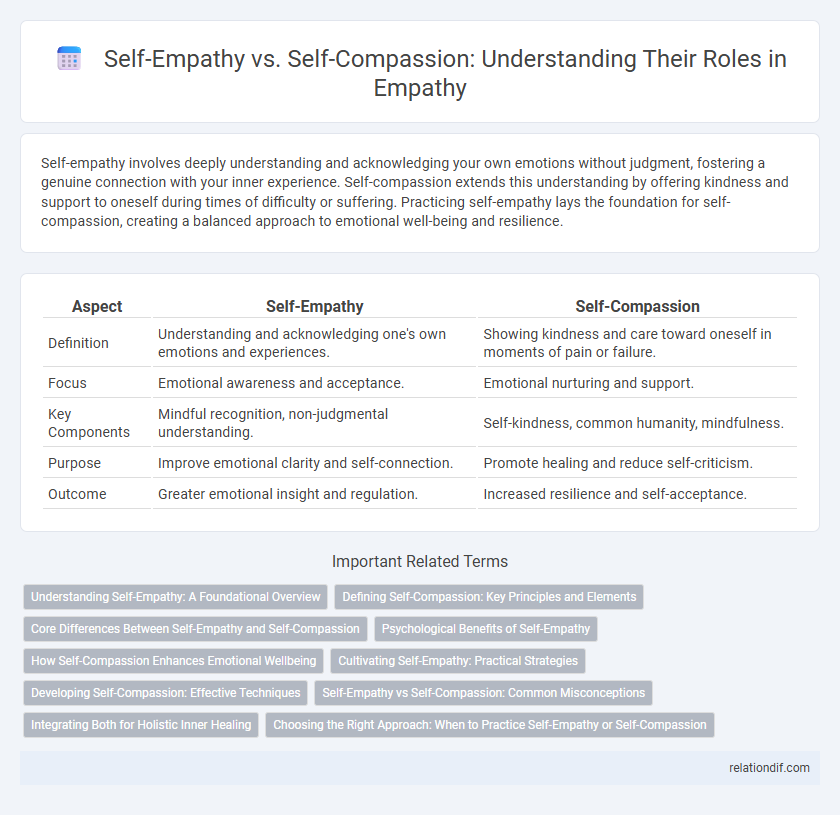Self-empathy involves deeply understanding and acknowledging your own emotions without judgment, fostering a genuine connection with your inner experience. Self-compassion extends this understanding by offering kindness and support to oneself during times of difficulty or suffering. Practicing self-empathy lays the foundation for self-compassion, creating a balanced approach to emotional well-being and resilience.
Table of Comparison
| Aspect | Self-Empathy | Self-Compassion |
|---|---|---|
| Definition | Understanding and acknowledging one's own emotions and experiences. | Showing kindness and care toward oneself in moments of pain or failure. |
| Focus | Emotional awareness and acceptance. | Emotional nurturing and support. |
| Key Components | Mindful recognition, non-judgmental understanding. | Self-kindness, common humanity, mindfulness. |
| Purpose | Improve emotional clarity and self-connection. | Promote healing and reduce self-criticism. |
| Outcome | Greater emotional insight and regulation. | Increased resilience and self-acceptance. |
Understanding Self-Empathy: A Foundational Overview
Self-empathy involves deeply recognizing and validating one's own emotions and experiences without judgment, serving as a foundational step in emotional awareness. Unlike self-compassion, which extends kindness and comfort to oneself during suffering, self-empathy focuses on clear, honest understanding and acceptance of inner feelings. Developing self-empathy enhances emotional resilience and fosters authentic self-connection essential for mental well-being.
Defining Self-Compassion: Key Principles and Elements
Self-compassion involves treating oneself with kindness, recognizing shared human experiences, and maintaining mindful awareness of personal suffering. It encompasses three core elements: self-kindness, common humanity, and mindfulness, which collectively support emotional resilience. Unlike self-empathy, which primarily emphasizes understanding one's emotions, self-compassion actively encourages nurturing and soothing oneself during challenges.
Core Differences Between Self-Empathy and Self-Compassion
Self-empathy involves deeply understanding and acknowledging one's own emotions without judgment, emphasizing emotional clarity and validation. Self-compassion combines this understanding with kindness, promoting a gentle and supportive stance toward oneself during suffering. The core difference lies in self-empathy's focus on emotional recognition, while self-compassion integrates this with warmth and encouragement for healing.
Psychological Benefits of Self-Empathy
Self-empathy involves deeply understanding and validating one's own emotions, which enhances psychological resilience and reduces stress by fostering emotional awareness. Unlike self-compassion, which emphasizes kindness toward oneself, self-empathy promotes active self-reflection and emotional clarity, leading to improved mental health outcomes such as decreased anxiety and depression. Research indicates that cultivating self-empathy can strengthen emotional regulation and support long-term psychological well-being.
How Self-Compassion Enhances Emotional Wellbeing
Self-compassion significantly enhances emotional wellbeing by fostering a kind and understanding attitude towards oneself during times of stress or failure. Unlike self-empathy, which centers on recognizing and validating personal feelings, self-compassion actively promotes emotional resilience by combining self-kindness, mindfulness, and a sense of common humanity. This holistic approach reduces negative emotions, lowers anxiety, and supports healthier coping mechanisms, ultimately leading to improved mental health outcomes.
Cultivating Self-Empathy: Practical Strategies
Cultivating self-empathy involves actively acknowledging and validating your emotions without judgment, which differs from self-compassion's emphasis on nurturing kindness toward oneself. Practical strategies include mindfulness meditation, which enhances emotional awareness, and journaling to explore internal experiences deeply. These techniques foster a conscious connection with your feelings, promoting psychological resilience and emotional intelligence.
Developing Self-Compassion: Effective Techniques
Developing self-compassion involves techniques such as mindful self-awareness, recognizing and validating personal emotions without judgment, and practicing self-kindness during moments of difficulty. Engaging in guided meditations and journaling exercises focused on gratitude and self-acceptance strengthens emotional resilience and reduces negative self-talk. These strategies cultivate a nurturing inner dialogue, promoting healing and psychological well-being.
Self-Empathy vs Self-Compassion: Common Misconceptions
Self-empathy involves deeply understanding and validating one's own emotions without judgment, while self-compassion actively includes kindness and support toward oneself during suffering. A common misconception is that self-empathy means merely feeling sorry for oneself, whereas it actually fosters emotional awareness that underpins genuine self-compassion. Confusing these concepts can hinder personal growth, as self-empathy serves as the foundation for self-compassion's healing practices.
Integrating Both for Holistic Inner Healing
Self-empathy involves deeply understanding and validating one's own emotions without judgment, creating a foundation for emotional awareness. Integrating self-compassion adds a nurturing and forgiving attitude, fostering resilience and reducing self-criticism. Combining both practices enhances holistic inner healing by promoting emotional balance and psychological well-being.
Choosing the Right Approach: When to Practice Self-Empathy or Self-Compassion
Self-empathy involves deeply understanding and acknowledging your emotions without judgment, which is crucial during moments of emotional turmoil or when processing complex feelings. Self-compassion emphasizes treating yourself with kindness and care, making it ideal for overcoming self-criticism or failure. Choosing the right approach depends on whether you need to explore your emotions honestly (self-empathy) or soothe and reassure yourself (self-compassion) to foster emotional healing and resilience.
Self-empathy vs Self-compassion Infographic

 relationdif.com
relationdif.com